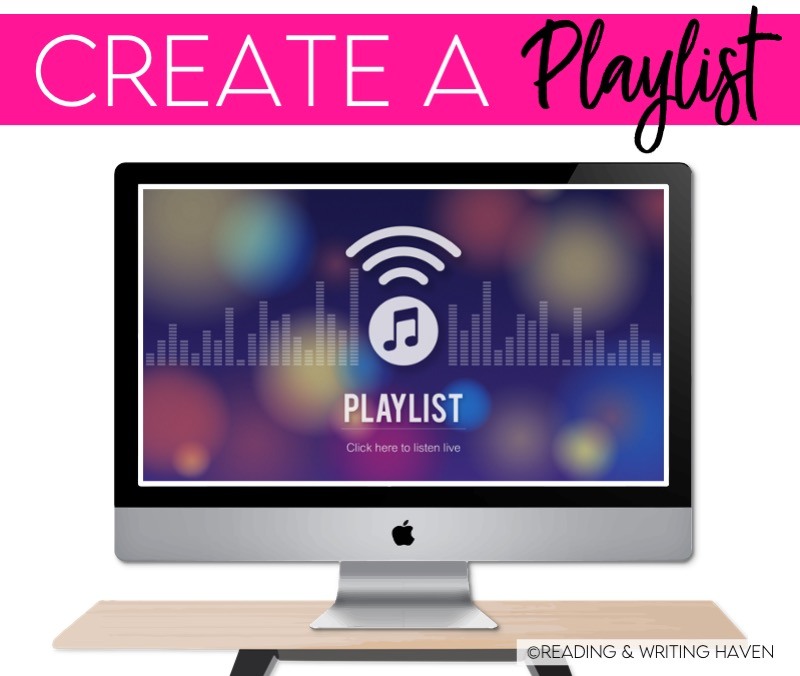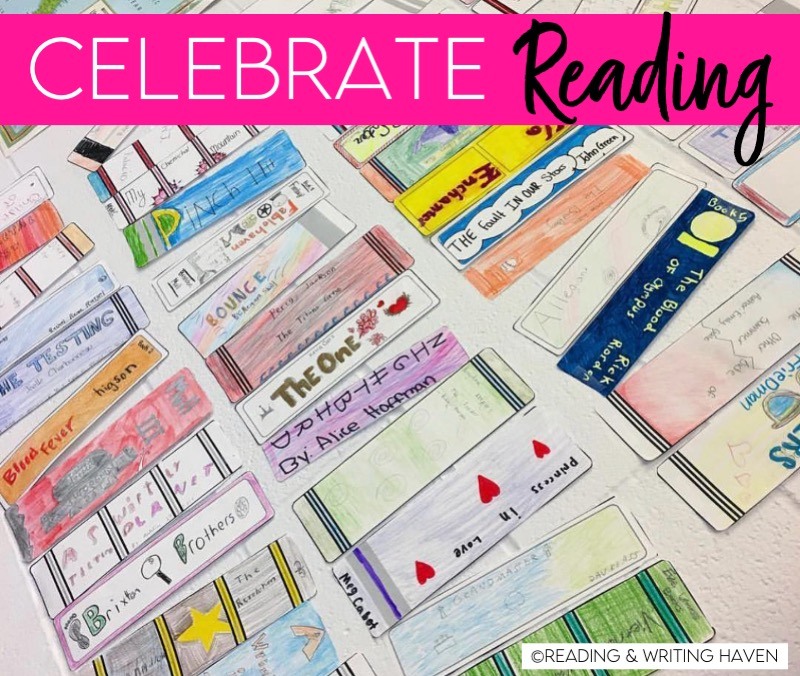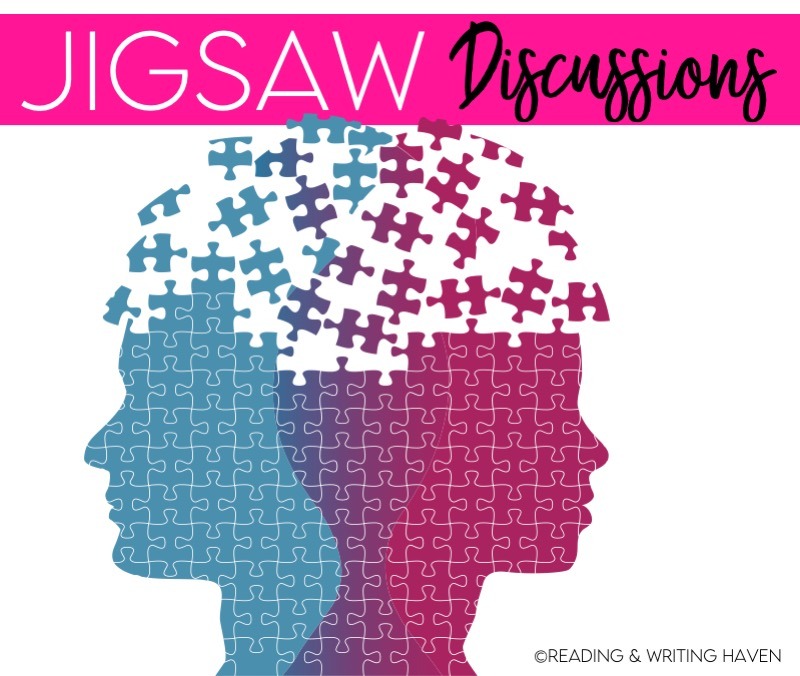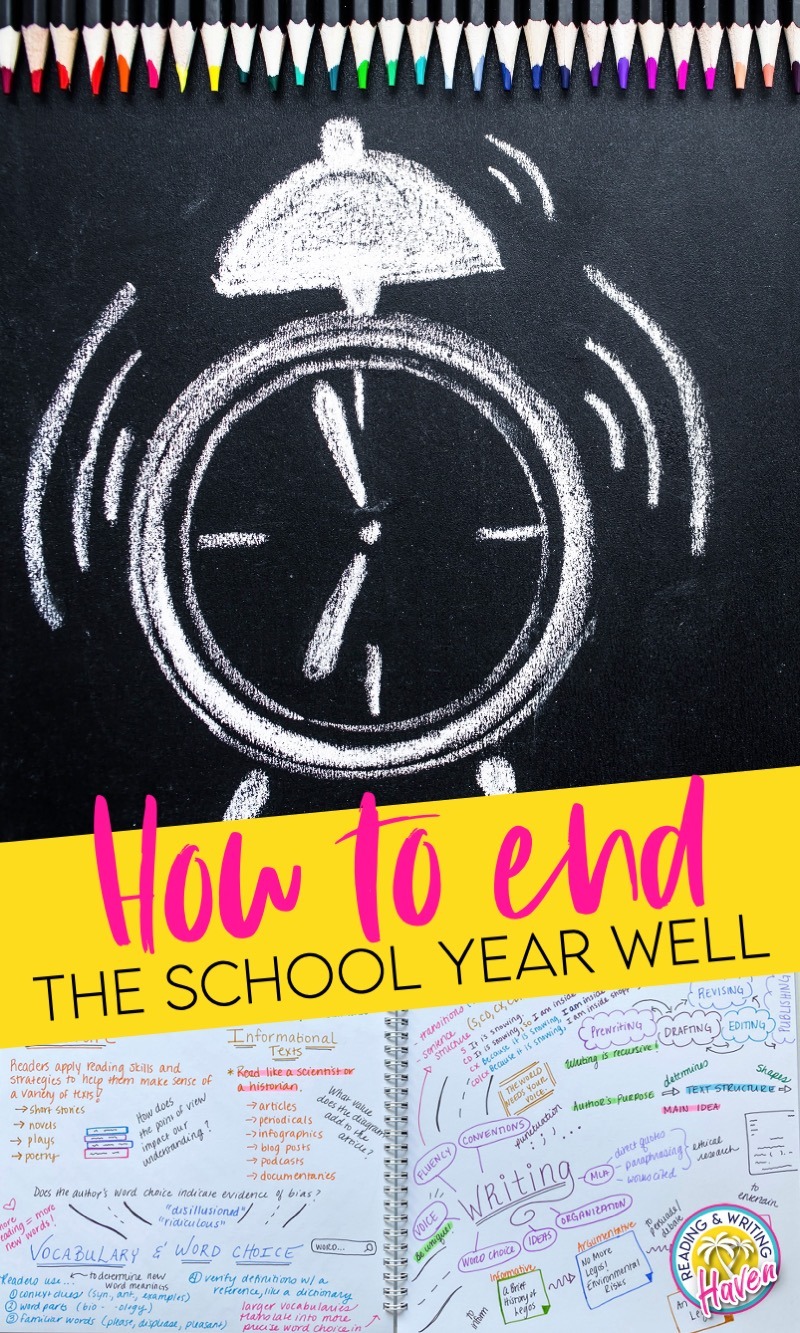Meaningful Ways to End the School Year
School’s out for summer! Well, not quite. But, the thought of summer break typically stirs butterflies in both teachers’ and students’ stomachs. Those flutters of excitement are nothing to feel guilty about. We’ve worked HARD all year, and we are ready for a little…er….long-ish break! But before we close out the year, we want to feel good about how we wrap up. Ending well matters. If you’re searching for meaningful ways to end the school year, you’ve come to the right place.
At the end of the year, my goals include:
- celebrating
- collaboration
- relationships
- goal setting
- engagement
- continued learning
While final exams are sometimes required, whenever possible I like to spend time leading up to the end of the year with community-building, critical thinking activities. Final exams serve a purpose for collecting summative data, forcing review, and holding students accountable, but they do little to nothing for building relationships or community. If you are not required to give final exams, you have a lot of flexibility! If you are required to give final exams, you can still choose to make your time reviewing both meaningful and engaging.
So, what are some meaningful ways to end the school year well? Let’s take a look at some fun closure strategies specifically for ELA classes!
1. MAP YOUR YEAR
One pagers have definitely struck a chord over the past few years. When students complete them well, they are truly synthesizing what they have learned about a topic (often literature). Sketchnotes have increased in popularity for similar reasons. If you love both of these options but are looking for something that is a little more comprehensive, let me introduce you to one of my new favorites: year mapping.
When students map their year in learning, they focus on synthesizing, making connections, asking questions, visualizing, summarizing, and evaluating their learning. Naturally, this thought process leads to goal setting for the next year. Year mapping is an amazingly powerful tool for collaboration (although it can be done individually as well). Students have a lot of voice and choice in terms of what they include on their maps and how they want to organize it.
Because students are truly in the driver’s seat after you introduce the assignment, as they work, the teacher is free to confer with individuals and groups. If students need a push, we can provide it by asking thoughtful questions and making key suggestions.
If you like this idea but want students to participate in more of a whole-group setting, try applying the same connection concept to a huge class mural (more strategic) or graffiti wall (less strategic).
The conversations students have with each other as they reflect on the course provides invaluable feedback to us, the teachers. Did they really get it? Did it stick? And, how can we use that information to adjust instruction moving forward?
I’ve created a time-saving resource with examples to help you get started. Grab it here!
2. CREATE A PLAYLIST
Reflection at its finest. What is better than having students reflect on their year (both personally and academically) while spiraling in grammar and writing skills they’ve learned in your course? Students love music, and all songs have meaning, so creating a playlist is relevant and engaging!
This lesson plan generally takes a few days, and it can involve as much or as little writing as you’d like. In May, the last thing most ELA teachers want to do is hunker down behind a screen or stack of essays, grading our free time away.
That’s why I love having students create a playlist. As they make their list, we can sit with them and confer. I’ve worked with individual students as well as small groups of students to re-teach or review important concepts they are expected to use in their writing. (Think: punctuation, sentence structure, coordinate adjectives, parts of speech) As you work with students give them feedback on their learning. If possible, go through a simple rubric with them, and ask them to self-assess.
And…don’t forget to play the school-appropriate songs while they work!
3. GATHER FEEDBACK
I won’t lie. Asking students to complete a course evaluation at the end of the school year can be a little nerve-wracking. What if students are brutal with their feedback?
A few may be. It can be difficult to swallow harsh feedback, but asking students for feedback on our course is imperative. I’ve always wanted to know what they thought. From their perspective, what was their experience in my class like? While some students may not provide helpful insights, I’ve been pleasantly surprised that many have.
When creating course evaluations, we can craft questions that increase the likelihood we will receive helpful feedback. For instance, instead of What was the most frustrating part of this class?, we can ask, What challenged your thinking most in this class? Creating questions that are multiple choice and collecting those ideas with a Google Form can streamline the process of digesting large amounts of data.
I ask some standard questions, but I love posing creative questions as well. I want students to think, to reflect, and to be aware of the way they chose to approach learning in my class throughout the year.
4. PLAY REVIEW GAMES
When the weather is warm, and summer is approaching, we can engage students by incorporating a variety of review games in our lesson plans. Whether we use these as a spiral review, as fast-finisher activities, or with learning stations, games bring learning and laughter to life. Games are a meaningful way to end the school year. Students are doing the thinking, but because they are engaged with interactive games, it doesn’t feel like work, and time goes by quickly!
Looking for meaningful ELA games that emphasize synthesis, collaboration, and critical thinking? Let’s consider a few options, (you can find a complete list of games I have created here)…
Word Games: Few things make me happier than listening to students use words they’ve learned over the course of the year in conversation with friends! Games like sticky words, QR associations, and speed dating put students in the critical thinking driver’s seat.
Truth or Dare: Whether students are reviewing key grammar concepts, using figurative language, or applying knowledge of new vocabulary, truth or dare has been a hit with many middle and high school students. Prompts naturally allow for low floor, high ceiling opportunities, which simplifies differentiation.
Dice Games: I use dice games to have students review grammar concepts (like sentence structure, parts of speech, and punctuation). Students deepen their knowledge of grammar concepts without even realizing it, which is exactly what we’re looking for with student-led activities.
Superlatives: Awards are not necessarily games, but they are a fun way to end the year and celebrate learning. Put a creative twist on end-of-the-year superlatives by having students give vocabulary words special awards! For example, Most Studious? erudite, of course! Would you like a free vocabulary superlative award you can use with students today? This one is editable in Google Slides.
5. CELEBRATE READING
If your classroom is built around any form of independent reading, it’s important to celebrate progress at the end of the year. Helping students reflect on their reading volume, reading diet, reading identity, and reading stamina are wonderful ways to build community. As a class, how many books were read? How many genres did students explore?
Allow students time to make book recommendations and to reflect on their growth as a reader. Not every student reads more books than the year before, but each year, every reader has the opportunity to set new goals. Did your students…
- try new genres this year?
- increase how long they can read in one sitting?
- grow their reading skills?
- begin recommending books to others?
- start reading in new locations?
- come to value reading as a lifelong hobby?
Activities for Celebrating Reading…
To end the school year well, there are literacy reflection points for everyone! Here are some simple, engaging activities to help students celebrate:
Reading Ladders: I like using a visual to help students reflect on book fit. How often are students reading books that fit them well? Do they try books that challenge them? And, do they take time to sit with books that are “easy” for them? All books have value. Using a reading ladder at the end of the year provides students with an overall picture of book fit for the year.
My Year in Reading: Have students reflect on their thinking as it relates to reading! Students enjoy writing a brief reflection, adding visuals, and evaluating a book overall.
Bookflix Bulletin Board: Build community by asking students to help create a digital or physical classroom Bookflix display. Students enjoy this popular reference to the hit streaming service, Netflix. Not only do students have ownership and voice in creating this class display, but also next year’s class gets to start off with some book recommendations from their predecessors!
Classroom Bookshelf (digital and print): One of the easiest ways for students to make book recommendations virtually is through a classroom bookshelf. They can take Instagram style photos and add what they just finished, what they are currently reading, and what’s up next in their “to read” stack.
You can find all of these bookish activities for community building, reflecting, and future reading in this creative alternatives to the reading log bundle.
6. CELEBRATE WRITING
Too often, writing takes a back seat during celebratory discussions in our classrooms. Even though writing is often hard work for both teacher and students, we can create positive associations with the experience by reflecting on and discussing the progress we’ve made over the course of a year.
Reflective Portfolios
Because most writing is digital now, students should be able to locate their compositions from the school year. Ask them to compile all of their work into a digital portfolio. There are so many ways to do this! For instance, students can create a portfolio cover and table of contents page in Google Slides. Then, they can link each of their writing samples to their titles on the table of contents.
Ask students to identify specific skills they worked on with each piece.
- With this essay, I really began to understand what it means to say the writing process is recursive.
- When I made this infographic, I learned how author’s purpose impacts text structure.
- Writing this poem encouraged me to think strategically about punctuation.
- My personal memoir, I learned to show instead of tell.
I’ve created a basic writing portfolio template you can use to get started.
Gallery Walks
For a less formal approach, put prompts around the room on big paper. Prompts should include a big thinking question and a writing skill. For example…
- Write about some specific ways our classroom became a community of learners and friends this school year. Include and annotate one of the comma rules you learned.
- Explore one of the challenges our world is currently overcoming this school year in one sentence. Annotate the sentence structure of your response.
- Compose a question that represents your curiosity about something you learned in our course this year. What more do you want to learn? In your answer, highlight a verbal.
Have students work in pairs, rotating around to each prompt and adding their thinking to the paper. As they do, they can also respond to peers’ comments. It’s simple to extend thinking by using underlines, stars, and thought bubbles.
7. JIGSAW DISCUSSIONS
If you want to emphasize discussion and student-led review, the jigsaw strategy is extremely powerful. Hattie lists jigsaw discussions as one of the teaching strategies that (when implemented successfully) can have the greatest impact on student learning over time.
With jigsaw discussions, students first form “expert” groups in which they take a deep dive into one topic of learning. With the other members of this expert group, students ask hard questions, review important takeaways from direct instructions, and further their understanding with research. Teachers often take time to sit with each expert group to coach them through their thinking.
When the expert groups have exhausted their topic, they prepare a short “lesson” they can take away from their group and use to teach their peers. Students in the expert group often practice this lesson with one another, talking through any visuals and activities they create to ensure they are all on the same page.
Then, it’s time to jigsaw! Expert groups split up, and new groups form. Let’s say you started with five expert groups, which each contained five students. The second group would then consist of five NEW groups. Each of them would have an expert from a different topic. And, they would proceed to teach one another!
Topics to Discuss
How could we end the school year well without discussions? But, there are SO MANY WAYS we can ask students to discuss. Jigsaws are a strategy I don’t typically use until students have a semi-solid grasp on the topic of study, which makes the end of the year an opportune time!
In order to get started with jigsaw discussions, you just have to start using them! No doubt, the first time through, you may find they don’t go as smoothly as you had hoped. Well-run jigsaws take some finessing. Selecting the best topics for jigsawing is part of the learning process. Here are some ideas…
- Grammar concepts (types of phrases, types of sentences, types of punctuation)
- Figurative language
- Modes of writing
- Writing skills
- Parts of the writing process
- Reading skills
- Elements of plot
Jigsawing chapters of a book is not usually effective, but focusing on specific skills or standards as they relate to literature can be powerful.
And, after students take turns teaching one another in their second groups, you can come together as a whole class to discuss how each of the jigsaw topics relates to the others!
You can read this post for twelve additional discussion formats that allow for discussion, community building, and conversation. Think gallery walks and musical debates!
Most importantly, when we plan how to end the school year, it matters what we do with students’ responses to these activities. Planning meaningful end-of-the-year lessons involves intentionally creating opportunities for students to reflect and collaborate but also for us to use what they create to continue growing in our practice.









These are great tips! I think a lot of these activities could even be modified for a high school classroom. I love the idea of student feedback. Even if they are brutal, they can only make you a better teacher! It makes me wonder, what is the most useful thing a student has ever said to you in feedback?
Hi Katie,
Thanks so much for reading! Such a GREAT QUESTION! Honestly, this is really hard for me to answer because every time I ask students for feedback, I get at least one suggestion that changes my teaching for the better.
To be transparent, I would say the most powerful feedback I’ve received from students has been in reading some of the harder-to-digest comments about how certain assignments stressed them out or seemed like busy work. Those comments have forced me to reflect on the true purpose for the assignment. Was it helping me to get to know them better as learners or just for accountability?
More often than not, when students find an assignment stressful, it’s because I haven’t done a great job of teaching them the skills they need or because the assignment was summative in nature, and students really needed more of my formative feedback and the opportunity to practice first.
Many times, the most valuable feedback has led me to include students more in the instructional creation and assessment process…giving them a larger voice. I hope that makes sense!
Melissa